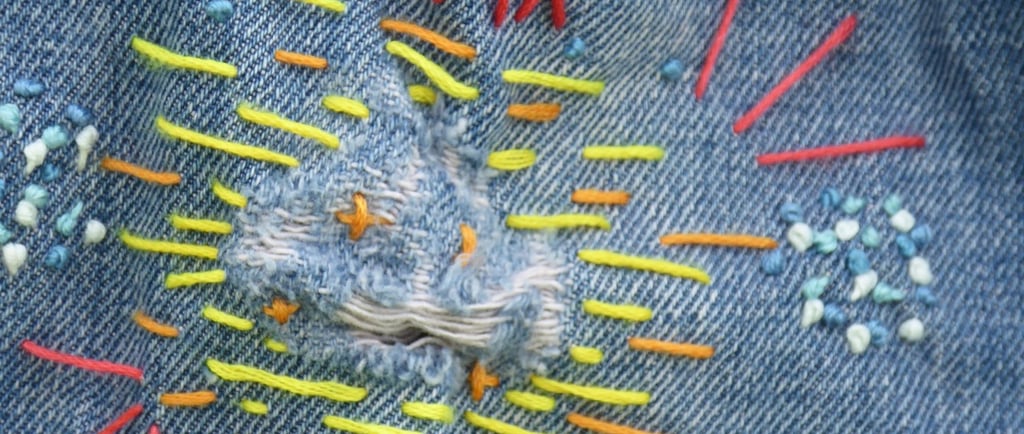BE DIFFERENT, BE FRESH - WEAR SOMETHING YOU CANT GET ANYWHERE ELSE - LET ME CREATE IT FOR YOU
Slow Stitch for Calm Reflection
Short article about stitching by hand
5/9/20253 min read


Hand stitching & Slow Stitching
Since about 2015, the trend for slow stitching as it is known now has been gradually building up momentum with an accelerated boost during lock down in 2020. Its a practice of mindfulness where the art of sewing each stitch by hand is more fascinating then the final outcome or its functionality as an object.
Although, many textile artists and creators are still making beautifully functioning slow stitch products which are full of use and function. Its been influenced by many of the core stitches that have remained in modern day but the earliest known stitches were recorded on bone needles and natural fibres 20,000 years ago. Simple running stitch has outlasted many generations of hand stitchers features strongly in many Sashiko designs which have been very much on trend since 2024.
Darning was a hand skill that was used for mending and even men were taught how to darn from a young age. Darning, involved repairing fabric, especially knitted items like socks, by interweaving new thread to fill holes or worn areas with a running stitch. It was a crucial skill for women, considered essential for household management and resourcefulness pre World War II. Darning was a common practice for repairing clothes until the mid-20th century, particularly during periods of rationing and economic hardship like World War II. However as the new world changed with cheaper cottons and fast fashion, this skill declined post the 1970's. If your socks fall apart now, you simply purchase a new pair. However, I've darned many a pair of socks! especially as Lycra is put into so many fibres these days!!
In the denim Jackets that are upcycled, you will find that hand stitching/ slow stitching is still very much part of the decoration journey with some of the new designs being featured in next months collection. Look for news on the website.
Well known stitches still used in 2025
From Running stitch to Blanket stitch you can beautiful pieces that will help release tension, calm the mind and give you a great sense of achievement. if you have a busy life and you are travelling for example on a daily basis by train, this is actually a project you can complete pretty much any where, it simply takes a few strands of embroidery thread which most would support and endorse DMC threads.
https://www.dmc.com Which are high quality threads with beautiful sheen and ease of use. Their pallet is vast, so you wont run out of ideas. I have included a blog written by Jo Morphett who is a contemporary textiles artist and her You Tube link to show you a simple project that you can complete.
One of the things I like to do is to take the pockets from old jeans and Sashiko then with white embroidery thread into traditional patterns and create small coin purses from them. It's both soothing and has a final purpose where spare pockets cut off old jeans are given a new lease of life. The repurposing prevents yet more denim fibre from heading to the landfills, creating more waste. It helps to calm my mind and to focus on my next design, drawing inspiration from the satisfaction of recreating with these pockets. Or alternatively I've used slow stitching to highlight like the picture above a hole or tear in the denim to make it a feature rather then tried to hide its faults or changes as it ages. one of my favourite stitches includes French knots. although originating many decades before in China and India the stitch became known as French knot when it was popularised by the French in the 16th century.
I find that combining the Running stitch with the French knot adds character to the stitch surface and creates a new form a texture. another great stitch to use is the variegated Satin stitch. Which helps to create a graduated finish especially if you use threads that have several shades of colour in the one thread. You create beautiful finishes quickly if you have plenty of strength and co-ordination in your hands and the easiest way to create a motif or shape is actually use a water soluble sheet which you can draw on your image, then tack it down with what is known as a tack stitch which is a simple double knot that can be removed at a later date. after stitching onto your fabric with your new slow stitch creation, you simply put it through a light wash or soak it in warmed water and the sheet will dissolve leaving you with wonderful threads neatly stitched into your fabrics. I hope you have enjoyed this blog, please subscribe to stay in touch on my contacts page.
Enjoy reading this article and signing up to Jo's You Tube.
https://www.jomorphett.com/post/my-top-3-embroidery-slow-stitches
.https://www.youtube.com/watch?v=3fCyIpyAxt0y post content
Address : Cheddar United kingdom
I wanted to create a range of designs that give each client individuality. It's about getting to know my clients on a deeper level, understanding their unique tastes and preferences.
By doing so, I can tailor my designs to reflect their personal style and bring their vision to life. Personalised Commissions accepted.
Contact us
redenimcrafts@aol.com
+44 7421 284228
Instagram RedenimCrafts
